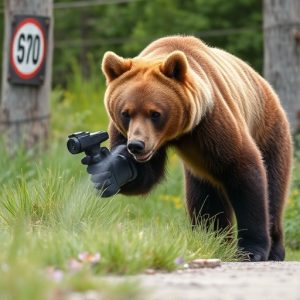Bear Spray Maximum Strength: Optimal Defense & Usage Techniques
Bear spray is a powerful defense tool for outdoor enthusiasts facing aggressive bears, containing ca…….
Bear spray is a powerful defense tool for outdoor enthusiasts facing aggressive bears, containing capsaicin to create an irritating mist. It's most effective as a last resort when used correctly close to the bear's face and eyes from 10-25 feet away, causing temporary discomfort that prompts the bear to flee. The best time to employ bear spray is during initial encounters at close range, with proper usage involving steady activation for 3-5 seconds based on manufacturer guidelines. Safety should always be paramount, as it's not a substitute for prevention but a tool for self-defense. Storage guidelines include keeping it out of reach and checking expiration dates regularly.
“Bears aren’t to be taken lightly, especially in their natural habitat. For outdoor enthusiasts navigating rugged terrain, knowing your defense options is vital. Enter bear spray—a powerful tool designed to deter aggressive bears when encountered. This article guides you through the essentials of bear spray, focusing on its maximum strength variant as a potent defense mechanism. We’ll explore when and how to use it properly, ensuring your safety in the wild. Learn about application techniques, storage, and crucial safety precautions.”
- Understanding Bear Spray: What It Is and How It Works
- When is Bear Spray Maximum Strength the Best Defense?
- Proper Usage Techniques for Optimal Effectiveness
- Safety Precautions and Storage Guidelines
Understanding Bear Spray: What It Is and How It Works
Bear spray, also known as bear deterrent or bear repellant, is a powerful defense weapon designed to protect individuals from aggressive bears. It’s a crucial tool for outdoor enthusiasts, campers, and anyone venturing into bear country. Understanding how it works is essential when considering its proper use. Bear spray is a liquid aerosol that contains a high concentration of capsaicin, the active ingredient found in chili peppers. When deployed, it creates a mist that the bear inhales, causing irritation to the bear’s eyes, nose, and respiratory system. This temporary yet intense discomfort prompts the bear to flee the area.
The effectiveness of bear spray lies in its maximum strength and quick-acting formula. It’s designed to be used as a last resort when confronted with an aggressive or defensive bear. The key to successful use is proper application: aim for the bear’s face, eyes, and nose at close range, ensuring the mist covers the animal completely. When used correctly, bear spray can significantly reduce the risk of injury during encounters with bears, offering a safe and effective means of self-defense in wild environments.
When is Bear Spray Maximum Strength the Best Defense?
Bear spray maximum strength is an effective defense weapon against aggressive bears, but it should be used properly for optimal effectiveness. The best time to utilize bear spray is when you find yourself in a situation where physical confrontation with a bear is imminent or unavoidable. This could occur during backcountry hiking, camping, or hunting in areas known to have bear populations.
When facing an approaching bear, understanding its behavior and reaction times is crucial. Bear spray is most useful as a deterrent when the bear is within 20-30 feet, giving it enough time to detect and react to the spray’s irritant. Proper usage involves aiming for the bear’s face and eyes, creating a barrier that temporarily blinds and disorients it, allowing you to retreat or gain a tactical advantage.
Proper Usage Techniques for Optimal Effectiveness
When to Use Bear Spray Properly & Optimal Application Techniques
Bear spray is a valuable defense weapon when encountering bears in the wild, but its effectiveness hinges on proper usage techniques. It’s crucial to understand that bear spray is most effective as a deterrent during initial encounters, not as a last resort when a bear has already charged. For optimal results, aim for the face and eyes of the bear, as these areas are sensitive and can prompt an escape response. Keep in mind that distance plays a significant role; closer ranges (10-25 feet) offer better coverage, while longer distances may result in reduced effectiveness due to spray dispersion.
Proper application involves releasing the nozzle steadily and holding it for several seconds to create a dense cloud of spray. Ensure you follow manufacturer instructions regarding the recommended time to keep the spray going—typically 3-5 seconds. It’s important to practice these techniques before venturing into bear country, as the stress of an actual encounter may impact your ability to execute them correctly. Additionally, staying calm and familiarizing yourself with the spray’s range and coverage area can significantly enhance its effectiveness during a potentially dangerous situation.
Safety Precautions and Storage Guidelines
When using bear spray, safety should always be a top priority. It’s crucial to understand that bear spray is not a substitute for avoiding encounters with bears, but rather a tool for self-defense in case of an attack. Always read and follow the manufacturer’s instructions before using it. Practice the application technique so you’re prepared if needed, but remember, prevention through awareness and distance is key.
Storage guidelines are also essential. Bear spray should be kept out of reach of children and pets. Store it in a cool, dry place, away from direct sunlight or extreme temperatures. Ensure the canister is not damaged or blocked, as this can affect its performance when needed. Regularly check the expiration date to ensure its potency remains optimal.
Bear spray, especially in its maximum strength formulation, can be an effective defense against bear encounters. Understanding when and how to properly use it is crucial for ensuring safety in backcountry settings. By adhering to the outlined usage techniques and safety precautions, individuals can maximize the effectiveness of bear spray as a last-resort defense mechanism. Remember, knowledge and preparation are key when navigating potentially dangerous wildlife encounters.


